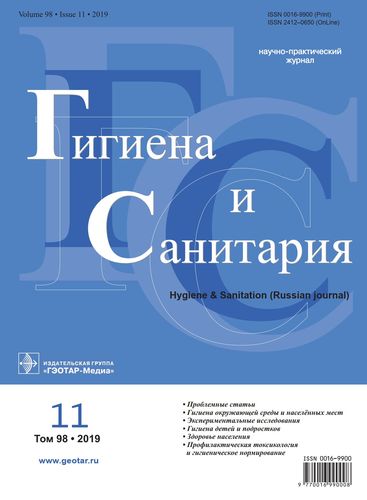How informative is the environmental rating of the regions of the Russian Federation
- 作者: Smirnova T.M.1, Melnichenko P.I.2, Prokhorov N.I.2, Krutko V.N.1,2
-
隶属关系:
- Federal Research Center “Computer Science and Control” of Russian Academy of Sciences
- Sechenov First Moscow State Medical University
- 期: 卷 98, 编号 11 (2019)
- 页面: 1222-1227
- 栏目: ENVIRONMENTAL HYGIENE
- ##submission.datePublished##: 14.10.2020
- URL: https://edgccjournal.org/0016-9900/article/view/639780
- DOI: https://doi.org/10.47470/0016-9900-2019-98-11-1222-1227
- ID: 639780
如何引用文章
全文:
详细
Introduction. All-Russian public organization "Green patrol" has developed a method of expert evaluation of environmental well-being. Since 2008 this method is used to calculate the environmental rating of regions of Russia. The ideology of rating takes into account the principles of sustainable development, in accordance with the Declaration of the UN Conference on environment and development. The consolidated environmental index includes three basic indices characterizing the state of the ecosphere, technosphere, and society.
The purpose of article is to assess the relevance of environmental rating of regions of Russia and its basic components to population health indices and therefore to assess the opportunities to use this rating for the prediction the environmental risks to human health.
Material and methods. We used data from the Federal State statistics service on morbidity, mortality and life expectancy in regions of Russia in 2008-2016, as well as environmental monitoring data for the same period, published by the "Green patrol". To evaluate the relationships between indicуs we used Spearman's rank correlation coefficient.
Results. None of the indeces of the population health showed a correlation with consolidated environmental index with significance level p < 0.05. The environmental index, which reflects the basic pollution levels of the environment, naturally had negative correlation coefficients with indeces of morbidity and mortality. Socio-economic and industrial-economic indices have identified a number of paradoxical correlations with health indices. This result is probably because the structure of these indices includes indicators reflecting the intensity of efforts to minimize industrial pollution and improve the quality of life of the population. This intensity is obviously higher the higher the need for it, so these indices indirectly reflect environmental disadvantage.
Conclusion. The results of the analysis showed a lack of informative value of the environmental rating of Russia's regions in terms of population health.
作者简介
Tatyana Smirnova
Federal Research Center “Computer Science and Control” of Russian Academy of Sciences
编辑信件的主要联系方式.
Email: smirnova.tatyana@gmail.com
ORCID iD: 0000-0002-8679-4934
MD, Chief researcher, Federal Research Center “Computer Science and Control” of Russian Academy of Sciences, Moscow, 119333, Russian Federation.
e-mail: smirnova.tatyana@gmail.com
俄罗斯联邦P. Melnichenko
Sechenov First Moscow State Medical University
Email: noemail@neicon.ru
ORCID iD: 0000-0002-3041-0372
俄罗斯联邦
N. Prokhorov
Sechenov First Moscow State Medical University
Email: noemail@neicon.ru
ORCID iD: 0000-0002-4510-2890
俄罗斯联邦
V. Krutko
Federal Research Center “Computer Science and Control” of Russian Academy of Sciences; Sechenov First Moscow State Medical University
Email: noemail@neicon.ru
ORCID iD: 0000-0002-2779-8775
俄罗斯联邦
参考
- Surzhikov V.D., Surzhikov D.V. The application of the multidimensional statistical methods in the evaluation of the influence of atmospheric pollution on the population’s health. Gigiena i sanitariya [Hygiene and Sanitation, Russian journal]. 2014; 93 (2): 41–4. (in Russian)
- Leshchenko Ya.A., Lisovtsov A.A. Evaluation of the quality of life in the population of the region by the multi-dimensional analysis. Gigiena i sanitariya [Hygiene and Sanitation, Russian journal]. 2018; 97 (10): 979–84. (in Russian)
- Environmental rating of the constituent entities of the Russian Federation. Ideology, conceptual model and methodology for calculating rankings. Available at: http://greenpatrol.ru/sites/default/files/styles/prezentaciya_reytinga_point_new_zamena_tablicy_-1_slayd_fon.pdf (accepted 6 November 2018). (in Russian)
- Environmental rating of the constituent entities of the Russian Federation. (in Russian). Available at: http://greenpatrol.ru/ru/stranica-dlya-obshchego-reytinga/ekologicheskiy-reyting-subektov-rf?tid=291 (accepted 6 November 2018).
- Health Care in Russia, 2009. Statistical Book. Moscow: Rosstat; 2009. (in Russian)
- Health Care in Russia, 2013. Available at: http://www.gks.ru/free_doc/doc_2013/zdravo.rar (accepted 6 November 2018). (in Russian)
- Application of the Statistical Book Health care in Russia, 2015. Available at: http://www.gks.ru/free_doc/doc_2015/pril_zdravo.rar (accepted 6 November 2018). (in Russian)
- Application of the Statistical Book Health care in Russia, 2017. Available at: http://www.gks.ru/free_doc/doc_2017/pril_zdravo.rar (accepted 6 November 2018). (in Russian)
- Application of the Demographic Yearbook of Russia, 2017. Available at: http://www.gks.ru/free_doc/doc_2017/pril-dem17.rar (accepted 28 January 2018). (in Russian)
- Regions of Russia. The main characteristics of the constituent entities of the Russian Federation. 2013. Statistical Book. Moscow: Rosstat; 2013. (in Russian)
- Regions of Russia. The main characteristics of the constituent entities of the Russian Federation. 2015. Statistical Book. Moscow: Rosstat; 2015. (in Russian)
- Regions of Russia. The main characteristics of the constituent entities of the Russian Federation. 2011. Statistical Book. Moscow: Rosstat; 2011. (in Russian)
- Regions of Russia. The main characteristics of the constituent entities of the Russian Federation. 2014. Statistical Book. Moscow: Rosstat; 2014. (in Russian)
- Regions of Russia. The main characteristics of the constituent entities of the Russian Federation. 2016. Available at: http://www.gks.ru/bgd/regl/B16_14s/Main.htm (accepted 28 January 2018). (in Russian)
- Russian Statistical Yearbook 2017: Statistical Book. Moscow: Rosstat; 2017. (in Russian)
- The level of income of the population in Russia and on the subjects of the Russian Federation for the year 2016. Available at: http://www.gks.ru/free_doc/new_site/population/bednost/tabl/1-2-6_2016.doc (accepted 1 August 2017). (in Russian)
- Rumyantsev G.I., Prokhorov N.I., Drosdova T.V. Trend assessment of causal-effective associations between the factors of inhabitation environment and population morbidity rate on the territory of placing a big range on buring solid waste materials. Acta Biomedica Scientifica. 2005; 40 (2): 143–7. (in Russian)
- Cho S.K., Sohn J., Cho J., Noh J., Ha K.H., Choi Y.J. et al. Effect of Socioeconomic Status and Underlying Disease on the Association between Ambient Temperature and Ischemic Stroke. Yonsei Med J. 2018; 59 (5): 686–92. https://doi.org/10.3349/ymj.2018.59.5.686
- Wu C.Y.H., Zaitchik B.F., Gohlke J.M. Heat waves and fatal traffic crashes in the continental United States. Accid Anal Prev. 2018; 119: 195–201. https://doi.org/10.1016/j.aap.2018.07.025
- Huynen M.M., Martens P., Schram D., Weijenberg M.P., Kunst A.E. The impact of heat waves and cold spells on mortality rates in the Dutch population. Environ Health Perspect. 2001; 109 (5): 463–70. https://doi.org/10.1289/ehp.01109463
补充文件







